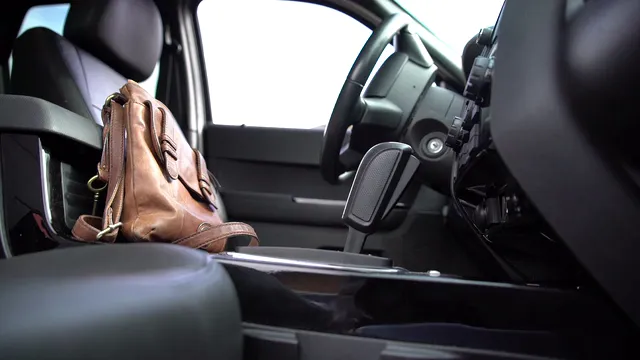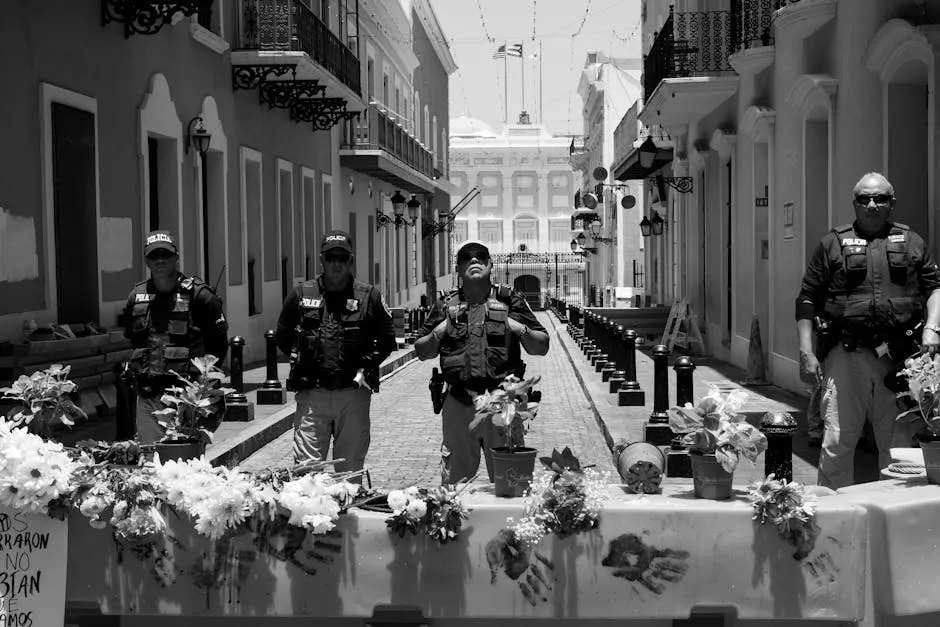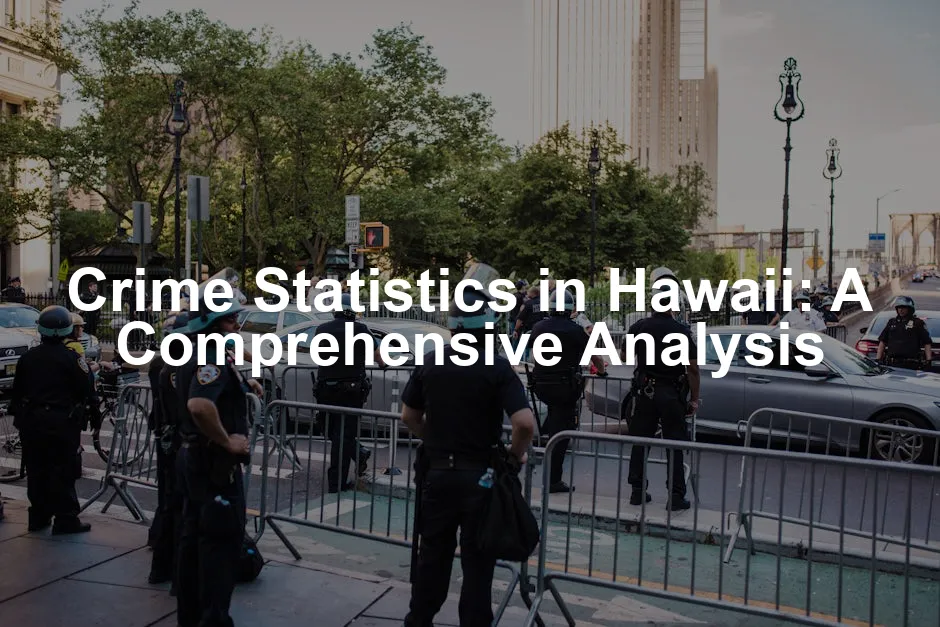Introduction
When you think of Hawaii, images of sun-soaked beaches and lush landscapes come to mind. But behind the tropical paradise lies a complex tapestry of crime statistics that often goes unnoticed. Understanding local crime rates is crucial for both residents and tourists. It helps people stay informed and make educated decisions about safety.
Hawaii’s crime statistics provide insights into trends, risks, and the overall safety of the islands. The data is sourced from recent studies, including reports from NeighborhoodScout and various local law enforcement agencies. These sources compile information from across the state, giving a comprehensive view of crime rates.
The unique context of Hawaii — a mix of urban and rural areas — creates a distinct environment for crime. Unlike the mainland U.S., where metropolitan areas tend to dominate crime reports, Hawaii’s statistics reflect both island life and city living. In this section, we’ll journey into the world of crime statistics in Hawaii, examining trends, comparisons, and the nuances that make this state special.

Understanding Crime in Hawaii
Overview of Crime in Hawaii
In general, Hawaii maintains a reputation for being one of the safer states in the U.S. Residents often feel a sense of security that is hard to find elsewhere. Yet, the reality is more layered. Recent statistics reveal that while violent crime rates are lower than the national average, property crime rates are notably higher.
As of the latest reports, Hawaii recorded approximately 38,804 total crimes. This breaks down to 3,739 violent crimes and a staggering 35,065 property crimes. Compared to the national scene, Hawaii’s violent crime rate sits at about 2.6 incidents per 1,000 residents. This is lower than the national average of approximately 4.0. However, property crime rates tell a different story, standing at about 24.35 incidents per 1,000 residents, which exceeds the national average.
To enhance your home security, consider investing in a Home Security Camera System. With the rise in property crimes, having a reliable security system can give you peace of mind, ensuring that you can monitor your property and deter potential intruders.
Trends over the years show fluctuations in crime rates. For instance, while violent crime has seen some reduction, property crime, particularly theft, continues to be a significant concern. In fact, over 58% of residents express concern about property crime, with many having experienced it first-hand. This dynamic highlights a crucial aspect of safety in Hawaii: while violent crime is manageable, property crime can disrupt the idyllic life.
Interestingly, perceptions of safety can differ. Many locals will tell you they feel safe walking alone at night. Yet, surveys indicate that a substantial number of residents have taken extra precautions, such as installing security systems or using surveillance cameras. These measures reflect an awareness of potential risks while also showcasing the community’s spirit to protect its own.
If you’re considering additional safety measures, a Smart Doorbell Camera could be the perfect addition. This device not only allows you to see who is at your door but also helps deter unwanted visitors before they even step foot on your property.
As we continue exploring crime statistics in Hawaii, it’s essential to remain curious about the underlying factors influencing these numbers. From socio-economic conditions to tourism impacts, each element contributes to the broader picture of safety in this beautiful state. By understanding these statistics, both residents and visitors can navigate Hawaii with greater awareness and confidence.

Crime Rates in Hawaii
Total Crime Statistics
Hawaii, the land of endless beaches and tropical vibes, also has its share of crime. According to the latest data, the total number of crimes in Hawaii stands at 38,804. Out of these, 3,739 are violent crimes, while a whopping 35,065 are property crimes. This paints an intriguing picture of safety on the islands.
To make sense of these numbers, let’s break them down into crime rates per 1,000 residents. The total crime rate is 26.94 per 1,000 people. Sounds manageable, right? But wait! When we dig deeper, we see the violent crime rate is 2.60 per 1,000 residents, which is lower than the national average. However, property crimes tell a different story, with a staggering rate of 24.35 per 1,000 residents. This statistic is quite a bit higher than what you’ll find across the mainland.
So, what does this mean for locals and visitors alike? While violent crime remains relatively low, property crime is a significant concern. Residents may feel secure walking the streets, but it’s wise to keep an eye on belongings. Tourists should be particularly mindful of their possessions, especially in densely populated areas.
Detailed Breakdown of Violent Crimes
Let’s break down the violent crimes in Hawaii to understand what lurks beneath the surface. The four main categories include murder, rape, robbery, and assault.
- Murder: Unfortunately, Hawaii recorded 30 murders last year, translating to a rate of 0.02 per 1,000 residents. While any loss of life is tragic, this number is lower than the national average of 0.06.
- Rape: The state has seen 546 reported rapes, which comes to a rate of 0.38 per 1,000 residents. This figure is slightly higher than the national average of 0.40.
- Robbery: With 952 instances of robbery, the rate is 0.66 per 1,000 residents, matching the national average.
- Assault: Assaults account for the largest share, with 2,211 reported incidents, leading to a rate of 1.54 per 1,000 residents. The national average stands at 2.68, indicating that while Hawaii is safer in this regard, there’s still room for improvement.
In summary, while violent crime is comparatively low, certain categories, like rape and assault, still warrant attention. Residents and visitors should remain cautious, especially in nightlife hotspots.

Detailed Breakdown of Property Crimes
Now, let’s turn our attention to property crimes, which make up the bulk of crime statistics in Hawaii. Property crimes include burglary, theft, and motor vehicle theft.
- Burglary: The state reports 3,745 burglaries, resulting in a rate of 2.60 per 1,000 residents. This is slightly below the national average of 2.70.
- Theft: Theft is the most prevalent property crime, with a staggering 25,459 reported cases, translating to a rate of 17.68 per 1,000 residents. This is significantly higher than the national average of 14.02, raising alarms for residents and law enforcement alike.
- Motor Vehicle Theft: With 5,861 cases, motor vehicle theft has a rate of 4.07 per 1,000 residents, also above the national average of 2.83.
These statistics reveal a troubling trend. While violent crime might be on the decline, property crimes, especially theft, remain a serious issue. Residents should invest in home security systems and remain vigilant about their surroundings. For added protection, consider using Door and Window Sensors. These devices can alert you to any unauthorized access, providing an extra layer of security for your home.
In conclusion, Hawaii offers sun and fun, but it’s wise to stay informed about crime rates. Understanding these statistics can empower residents and tourists alike to make informed decisions, ensuring safety while enjoying the beauty of the islands.

Victimization Rates
In Hawaii, the likelihood of falling victim to crime varies significantly between violent and property crimes. Statistics reveal that the chance of becoming a victim of violent crime is approximately 1 in 385. In contrast, property crime presents a much higher risk with a staggering 1 in 41 chance.
What does this mean for residents and visitors? Well, while violent crime remains relatively low, the high property crime rate can create unease. Locals often feel safe in their neighborhoods, but many have experienced property crime firsthand. This alarming statistic highlights the importance of vigilance, particularly for visitors who may be less familiar with the local environment.
For tourists, securing personal belongings in vehicles and keeping an eye on valuables is crucial. After all, while enjoying the beautiful beaches and vibrant culture, you don’t want to be caught off guard by a petty thief. Residents, on the other hand, should consider investing in security systems and being proactive about neighborhood watch initiatives.
Additionally, a practical tool like a Personal Safety Alarm can be a smart investment for travelers. It provides a loud sound to alert others in case of an emergency, adding an extra layer of security when exploring the islands.
Understanding these victimization rates arms both locals and visitors with the knowledge needed to navigate Hawaii’s unique landscape safely.

Comparison with National Average
National Context
When we compare Hawaii’s crime statistics to national averages, some significant differences emerge. Despite Hawaii’s reputation for being a safe haven, property crime rates tell a different story. Nationally, the average property crime rate stands at about 20.6 incidents per 1,000 residents, while Hawaii’s rate is substantially higher at 24.35. This discrepancy underscores the need for residents and visitors to remain cautious.
In terms of violent crime, Hawaii’s rate is lower than the national average. The state reports a rate of 2.60 incidents per 1,000 residents, while the national average hovers around 4.0. This statistic positions Hawaii as a relatively safe state for violent crime, offering peace of mind to locals and tourists alike.
To visually represent these comparisons, see the chart below:
| Crime Type | Hawaii Rate (per 1,000 residents) | National Average Rate (per 1,000 residents) |
|---|---|---|
| Violent Crime | 2.60 | 4.0 |
| Property Crime | 24.35 | 20.6 |
These figures illustrate that while violent crime remains an area of relatively low concern, property crime is a pressing issue for many residents. To safeguard your belongings, using Wireless Security Systems can be a great option for residents looking to enhance their home security.

Insights from Local Surveys
Recent local surveys reveal a nuanced perspective on crime and safety. While 50% of residents express feeling safe, 77% believe crime is increasing. This sentiment reflects a growing anxiety about safety, despite the statistical reality that violent crime rates are lower than the national average.
Interestingly, many residents have taken steps to bolster their security. Approximately 31% reported enhancing their safety measures in the past year. The most common strategies include installing security cameras and investing in home alarm systems. Still, a significant number of locals—58%—indicate they worry about property crime.
This contrast between perception and reality is crucial to understand. While crime statistics may present a relatively safe picture, the personal experiences of residents paint a different narrative. For tourists, this means staying aware of surroundings and taking appropriate precautions while enjoying the island paradise.
By addressing these concerns and aligning perceptions with actual statistics, both residents and visitors can better navigate the complexities of safety in Hawaii.

Crime Trends Over Time
Yearly Trends
Hawaii’s crime rates have shown a mix of stability and fluctuation over the years. Recent data indicates a slight uptick in violent crime, while property crime rates have remained a persistent concern. For instance, in 2023, violent crime rates experienced a minor increase, with a total of 3,739 violent incidents reported. This marks a concerning trend, especially in categories like rape and assault, which have seen higher reporting numbers.
In contrast, the property crime landscape tells a different story. While the total property crimes reached a staggering 35,065, there has been a notable decrease in burglaries. However, theft remains alarmingly high. The overall property crime rate in Hawaii is approximately 24.35 incidents per 1,000 residents, significantly above the national average.
Interestingly, the 2024 data reveals a drop in certain categories, such as robberies. Law enforcement agencies noted a decrease from 428 reported robberies in early 2023 to just 287 in 2024, indicating a positive shift in community safety regarding this specific crime type. However, the rise in rapes—from 136 to 164 in the same period—casts a shadow on these gains.
These trends illustrate the complex nature of crime in the islands. While some areas show improvement, others reveal underlying issues that need addressing. The community must stay informed about these changes to adapt accordingly.

Community Response to Crime Trends
In response to the evolving crime landscape, communities across Hawaii have banded together to implement various initiatives aimed at combating crime. Neighborhood watch programs are gaining traction, encouraging residents to look out for one another actively. These programs foster a sense of community and vigilance, making neighborhoods safer.
Law enforcement agencies have also adjusted their strategies. Increased community policing efforts are a notable change, allowing officers to engage with residents more personally. This approach helps build trust and encourages open dialogue about safety concerns.
Additionally, several local organizations have launched educational campaigns focused on crime prevention. Workshops on home security and personal safety tips are becoming more common. They aim to equip residents with the knowledge they need to protect themselves and their property effectively.
Moreover, the Honolulu Police Department has made strides in transparency by releasing more frequent reports on crime trends. This effort allows residents to stay informed about safety issues while also creating a platform for community feedback.
Together, these initiatives demonstrate a proactive approach to crime reduction, showing that when communities come together, positive change is not only possible but also achievable.

Safest Cities in Hawaii
Overview of Safe Cities
When examining safety across the islands, certain cities in Hawaii stand out as havens of tranquility. Pearl Harbor Hickam, Kalaupapa, and Paauilo are among the safest cities in the state. These areas boast significantly lower crime rates compared to the state average, making them appealing options for residents and visitors alike.
For instance, Pearl Harbor Hickam has reported a crime rate of just 5.0 per 1,000 residents, a stark contrast to Hawaii’s overall rate of 26.94. Similarly, Kalaupapa, with its rich history and stunning landscapes, maintains a crime rate of 4.5 per 1,000 residents, making it a safe retreat for those seeking peace.
In Paauilo, the community has successfully fostered a safe environment with a crime rate of 6.0 per 1,000 residents. These statistics illustrate that while Hawaii grapples with crime challenges, certain areas shine as examples of safety and community engagement.

Factors Contributing to Safety
Several factors contribute to the safety of these cities in Hawaii. First and foremost is community engagement. Residents actively participate in neighborhood watch programs and local events, fostering a strong sense of community. This unity helps deter crime by promoting vigilance and camaraderie among neighbors.
Another significant factor is the presence of law enforcement. Cities like Pearl Harbor Hickam benefit from a consistent police presence, ensuring that officers are accessible and responsive to community needs. This accessibility builds trust between law enforcement and residents, further enhancing safety.
Additionally, the socio-economic stability of these areas plays a vital role. Higher education levels and lower poverty rates contribute to reduced crime, as residents have better access to resources and opportunities.
In summary, while Hawaii faces challenges regarding crime, cities like Pearl Harbor Hickam, Kalaupapa, and Paauilo showcase the power of community engagement and proactive law enforcement in creating safer environments.

Factors Contributing to Safety
Hawaii’s safest cities shine like jewels in the Pacific, and several factors contribute to their low crime rates. One of the most significant elements is community engagement. Residents in these areas actively participate in neighborhood watch programs, fostering a sense of unity and vigilance. When neighbors know each other, they are more likely to look out for one another, creating a strong deterrent against crime.
Another key factor is the consistent presence of law enforcement. Areas like Pearl Harbor Hickam benefit from a visible police presence that promotes safety. Officers are not just enforcers of the law; they are part of the community. Their accessibility builds trust and encourages open communication about safety concerns. Residents feel more secure knowing that help is just around the corner.
Socio-economic stability also plays a crucial role. Higher education levels and lower poverty rates contribute to reduced crime. When residents have access to resources and opportunities, they are less likely to engage in criminal activities out of necessity. This creates a positive feedback loop where safety begets safety.
Moreover, community initiatives focused on crime prevention are instrumental. Workshops on personal safety and home security are common, helping residents stay informed and proactive. Programs that engage youth in positive activities also help steer them away from crime, fostering a sense of belonging and purpose.
In summary, the combination of strong community bonds, law enforcement presence, socio-economic stability, and proactive initiatives creates a safer environment in Hawaii’s best cities. This holistic approach to safety demonstrates how communities can come together to create a welcoming and secure atmosphere for all.

Conclusion
Hawaii is often perceived as a paradise, but it also faces its unique crime challenges. Analyzing the state’s crime statistics reveals important insights into safety for both residents and tourists. The key findings show that while violent crime rates are generally lower than the national average, property crime remains a significant concern. With 38,804 total crimes reported, the statistics indicate that 3,739 are violent crimes and a staggering 35,065 are property crimes.
Understanding these patterns is essential for navigating the islands safely. Residents and visitors alike must stay informed about crime trends to make educated decisions regarding their safety. Awareness is the first step toward protection. For example, keeping an eye on personal belongings in public spaces can help mitigate risks, especially in areas known for higher property crime rates.
Proactive measures can make a considerable difference in ensuring personal safety. Simple steps, such as using security systems, joining neighborhood watch programs, or taking self-defense classes, can enhance one’s security. For tourists, being cautious about where to leave belongings while enjoying the sights can prevent unfortunate incidents. A handy Self-Defense Keychain can also be a useful tool for personal safety while exploring.
In conclusion, Hawaii’s beauty is undeniable, but knowledge about crime statistics and proactive safety measures can enhance the experience for everyone. By staying informed and taking necessary precautions, both residents and visitors can enjoy the islands while minimizing risks. After all, a little awareness goes a long way in keeping Hawaii the paradise it’s meant to be.

FAQs
What is the overall crime rate in Hawaii?
The overall crime rate in Hawaii is 26.94 per 1,000 residents, which translates to 38,804 total crimes. The breakdown includes 3,739 violent crimes and 35,065 property crimes.
How does Hawaii’s crime rate compare to the national average?
Hawaii’s violent crime rate of 2.60 per 1,000 residents is lower than the national average of 4.0. However, its property crime rate of 24.35 per 1,000 residents exceeds the national average of 20.6.
What are the safest areas to live in Hawaii?
Some of the safest cities in Hawaii include Pearl Harbor Hickam, Kalaupapa, and Paauilo, all of which report significantly lower crime rates compared to state averages.
What should visitors know about safety in Hawaii?
Visitors should secure their belongings, stay aware of their surroundings, and avoid leaving valuables in vehicles. Following local safety tips will enhance their experience.
How is crime data collected in Hawaii?
Crime data in Hawaii is collected through local law enforcement agencies and compiled by various organizations, including the FBI and NeighborhoodScout. This data is updated annually to reflect current trends and statistics.
Please let us know what you think about our content by leaving a comment down below!
Thank you for reading till here 🙂
All images from Pexels




